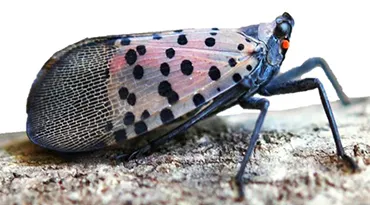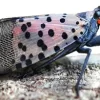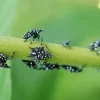X
CONTACT US
Great Lakes Center, SAMC 319
SUNY Buffalo State
1300 Elmwood Ave., Buffalo, NY 14222
wnyprism@buffalostate.edu
(716) 878.4708
SUBSCRIBE TO LISTSERV
FOLLOW US
CONTACT

Spotted Lanternfly, Lycorma delicatula, Lateral, photo by Lawrence Barringer, Pennsylvania Department of Agriculture
Spotted Lanternfly
COMMON NAME:
Spotted LanternflySCIENTIFIC NAME:
Lycorma delicatulaORIGIN:
AsiaDESCRIPTION:
Adult spotted lanternfly have large, visually striking wings, and are approximately 1'' long and 1/2'' wide. Their forewings are light brown with black spots at the front and a speckled band at the rear. Their hind wings are scarlet with black spots at the front, and white and black bars at the rear. Their abdomen is yellow with black bars. Nymphs in their early stages of development appear black with white spots and turn to a red phase before becoming adults. Egg masses are yellowish-brown in color, covered with a gray, waxy coating prior to hatching.HABITAT:
The spotted lanternfly is an invasive planthopper known to use tree-of-heaven, Ailanthus altissima, another invasive species, as its primary host. It has been detected feeding on and impacting many plants, including agricultural commodities such as apples, plums, cherries, grapes, peaches, and nectarines. It also feeds on oak, walnut, poplar and other native species. The insect will change hosts as it goes through its developmental stages. Nymphs feed on a wide range of plant species, while adults prefer to feed and lay eggs on tree-of-heaven.THREAT:
Both nymphs and adults of spotted lanternfly cause damage when they feed, sucking sap from stems and leaves. This can reduce photosynthesis, weaken the plant, and eventually contribute to the plant’s death. In addition, feeding can cause the plant to ooze or weep, resulting in a fermented odor, while the insects themselves excrete large amounts of fluid (honeydew). This fluid promotes mold growth and attracts other insects.MANAGEMENT:
Spotted lanternfly management will vary based on whether the insect is found inside or outside existing quarantine areas, which are continually shifting to keep up with new detections. Keep up with quarantine areas by checking with the Pennsylvania Department of Agriculture and New York State Department of Environmental Conservation. Within quarantine areas, egg sacs should be scraped off the host surface, soaked in alcohol or hand sanitizer, double bagged and thrown away. Report all sightings of spotted lanternfly directly to your PRISM or state agency, or through iMapInvasives.
SYMPTOMS:
Attacked trees develop weeping wounds which leave a grey to black trail along the trunk. This sap, or 'honeydew' attracts other insects to feed. In late fall, adults lay egg masses on host trees and nearby smooth surfaces like stone and even outdoor furniture or cars.
WNY PRISM PRIORITY:
Early Detection Priority Species
Tier 2 - Eradication
ADDITIONAL RESOURCES:
Help stop the spread!
Learn to identify this pest during each life stage and take action to not transport it. Tree-of-heaven is the preferred host of the spotted lanternfly. Help us stop the spread of the spotted lanternfly by reporting tree-of-heaven infestations to spottedlanternfly@agriculture.ny.gov and monitoring stands of tree of heaven for this dangerous insect.
Spotted Lanternfly Found in Western New York! Public asked to report sightings to the Department of Agriculture and Markets.
From Department of Agriculture and Markets Press Release - 9/9/2022
"The New York State Department of Agriculture and Markets is asking residents in Western New York to be on the lookout for Spotted Lanternfly (SLF), after a population was found in the Buffalo area this week. SLF is a destructive pest that feeds on more than 70 plant species, including tree-of-heaven, and plants and crops that are critical to New York’s agricultural economy, such as grapevine, apple trees, and hops. The invasive was first observed in New York State on Staten Island in August 2020, and since then the population has been reported in all New York City boroughs, Long Island, Port Jervis, Sloatsburg, Orangeburg, Ithaca, Binghamton, Middletown, Newburgh, Highland, and now in the Buffalo area."
"While surveys in the area are ongoing, the Department is asking for the public’s help in slowing down the spread of SLF in this area by reporting any sightings immediately to agriculture.ny.gov/reportSLF.
In addition to reporting, residents are asked to:
- Take pictures of the insect, egg masses, or infestation you see and, if possible, include something for size, such as a coin or ruler.
- If possible, collect the insect. Place in a bag and freeze, or in a jar with rubbing alcohol or hand sanitizer.
- Note the location (street address and zip code, intersecting roads, landmarks, or GPS coordinates)."
Additional Resources:
NYS Department of Agriculture and Markets (NYS DAM)
NYS Regulations on Spotted Lanternfly Quarantine
NYS Prohibited and Regulated Species - Part 575:
PATHWAYS OF INVASION:
It is believed that spotted lanternfly arrived in the United States as an egg mass, stuck to a pallet or other shipping material. Spotted lanternfly will lay eggs on pretty much any smooth surface. Individual adults don't move very far on their own, but are easily transported by people on cars and other vehicles. Egg masses are also easily transported by people.
REGIONAL DISTRIBUTION:
Single known population in the WNY PRISM region, located in Buffalo.
MAP (via iMapInvasives):
To view more information for each point, zoom in, click on the point and select the "Maximize" symbol. Click "More info" to open the iMapInvasives record.
This map shows confirmed observations (green points) submitted to the NYS Invasive Species Database.
Absence of data does not necessarily mean absence of the species at that site, but that it has not been reported there.
For more information, please visit iMapInvasives.





